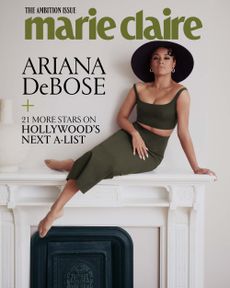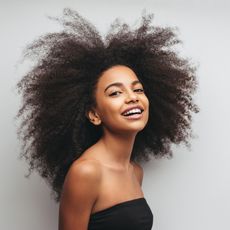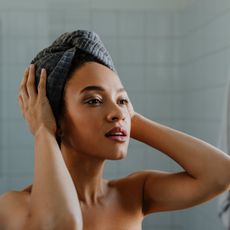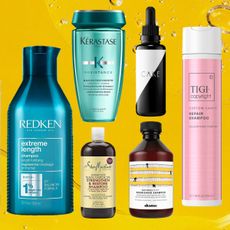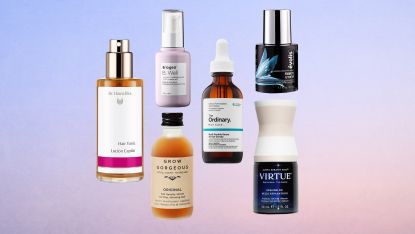
Whether the issue was a bad haircut, a case of COVID, or thinning strands, just about all of us have struggled at some point to grow out our hair. And while the key to healthy hair growth is a healthy lifestyle (i.e., hydrating, eating well, and sleeping enough), there are also a number of topical products, like hair growth shampoos and hair growth vitamins, that can enhance scalp health and stimulate hair growth alongside your regular shampoo and conditioner. One of my go-tos is hair growth oil, which can easily be applied to the scalp to give your hair growth regimen an extra boost.
But how do hair growth oils work, you ask? We spoke to Dr. Mona Gohara, a dermatologist who serves as Vice President of the Women’s Dermatologic Society at Yale University and is an active member of The American Academy of Dermatology and The American Society For Dermatologic Surgery, to get the lowdown.
"Hair growth oils are serums that help restore nutrients to your scalp and increase stimulation and hair production," Dr. Gohara explains. "Oils can thicken the cuticle, making the hair appear fuller. As the hydration is absorbed, the cuticle expands giving the appearance of growth."
- Best Overall Hair Growth Oil: Philip Kingsley Density Preserving Drops
- Best for Sensitive Scalps: Juices & Botanics Gentle Formula: The Drip Gentle Healthy Hair Growth Elixir
- Best for Hair Regrowth: Olaplex No. 7 Bonding Hair Oil
- Best for Minimizing Shedding: Natucain Hair Activator
- Best Natural Hair Growth Oil: Briogeo B. Well Organic + Cold-Pressed 100% Castor Oil
What to Look for in a Hair Growth Oil
With so many hair oils on the market, it may be difficult to determine which ones are best for your hair type and needs. For that reason, we asked Dr. Peter Young, a board-certified dermatologist and medical director for Keeps, to demystify hair growth oils and the best, tried-and-true ingredients to look for when shopping for one. He reiterates the previously stated point that these ingredients support healthy hair growth, giving the appearance of thicker hair, rather than growing net-new hair from nowhere. However, they can still go a long way in terms of giving you the mane of your dreams.
"Your hair has fat in it, and oils are pretty much pure fat, so putting them on your hair can help restore those naturally-occurring fats," Dr. Young explains. "Oils high in saturated and monounsaturated fats are good because these types of fatty acids penetrate the hair strand more easily. Oils with polyunsaturated fats, on the other hand, don’t have the same effect."
Examples of some of these optimal fats? "One option is coconut oil," he says. "In fact, one study showed that coconut oil assisted with decreasing how much protein the hair lost, which basically means it prevented the hair from getting weaker. Another oil that’s high in saturated fat is palm oil (such as saw palmetto oil), and some options high in monounsaturated fats are almond oil, olive oil, and argan oil."
When shopping for hair growth products of all types, he also recommends "plant-based, organic, and raw" ingredients such as biotin, caffeine, and green tea. These, in addition to the aforementioned, are "science-backed ingredients designed to support hair growth and give the appearance of thicker, healthier-looking hair."
How to Use Hair Growth Oil
If you've never used a hair oil before, applying it for the first time can be a baffling experience. It's important to remember that hair growth begins with a healthy scalp. For that reason, Dr. Gohara says, "Hair growth oils are massaged into the scalp to stimulate the hair at the root. Once you’ve shown your scalp lots of love, you can carry the product through to the ends."
How Often to Use Hair Oils
When it comes to how often to use your hair oil, Dr. Gohara reminds us to read the instructions for your oil of choice very carefully. "Following the instructions on your hair growth oil is imperative because some oils have you apply once a day while others are more frequent," she points out. She adds that it's perfectly all right to use multiple hair products at once, so long as you "couple your hair growth oils with a shampoo and conditioner routine to make sure your hair is getting as clean and nourished as possible." Clarifying shampoos, in particular, she says, "are perfect companions for hair growth oils."
Still worried that adding an oil to your regimen will make your hair look greasy? "A lot of hair growth oils are applied before you shower," says Dr. Gohara. "However, if you have one that needs to be applied in the morning, you can always rock a sleek bun or pony!"
The Best Hair Growth Oils
The products on this list have either been tested and vetted by Marie Claire's E-Commerce Writer, Gabrielle Ulubay (aka yours truly), Marie Claire's Beauty Director, Deena Campbell, and Marie Claire's Beauty Editor, Samantha Holender; or have been hand-selected by a hair stylist or board-certified dermatologist. Each one includes ingredients clinically proven to support healthy hair growth and support a healthy scalp, and is highly rated by reviewers. While the *best* hair growth oil for you will vary based on factors such as skin type, hair type, and personal preference, you truly can't go wrong with one of the items on this list. For a more personalized recommendation or if you have any concerns, check with your board-certified dermatologist or trichologist.

These are the scalp drops I use most, and I swear by them. I simply apply the liquid to my scalp along part lines spaced about an inch apart, across the top of my head. It helps reduce breakage and thinning—something I especially needed after suffering from stress-induced hair shedding. Developed by the Philip Kingsley Trichological Clinic, which is based in New York City, the formula is packed with powerful ingredients like caffeine, saw palmetto, glycerin, and azelaic acid.
Pros: editor-approved; alcohol-free; made with botanical ingredients; clinically tested
Cons: expensive
Customer Review: "I have tried others, this is the best. There is no stickiness and you cannot feel the product on your scalp after using. The hair around my hairline feels and looks slightly thicker." -FeelUnique
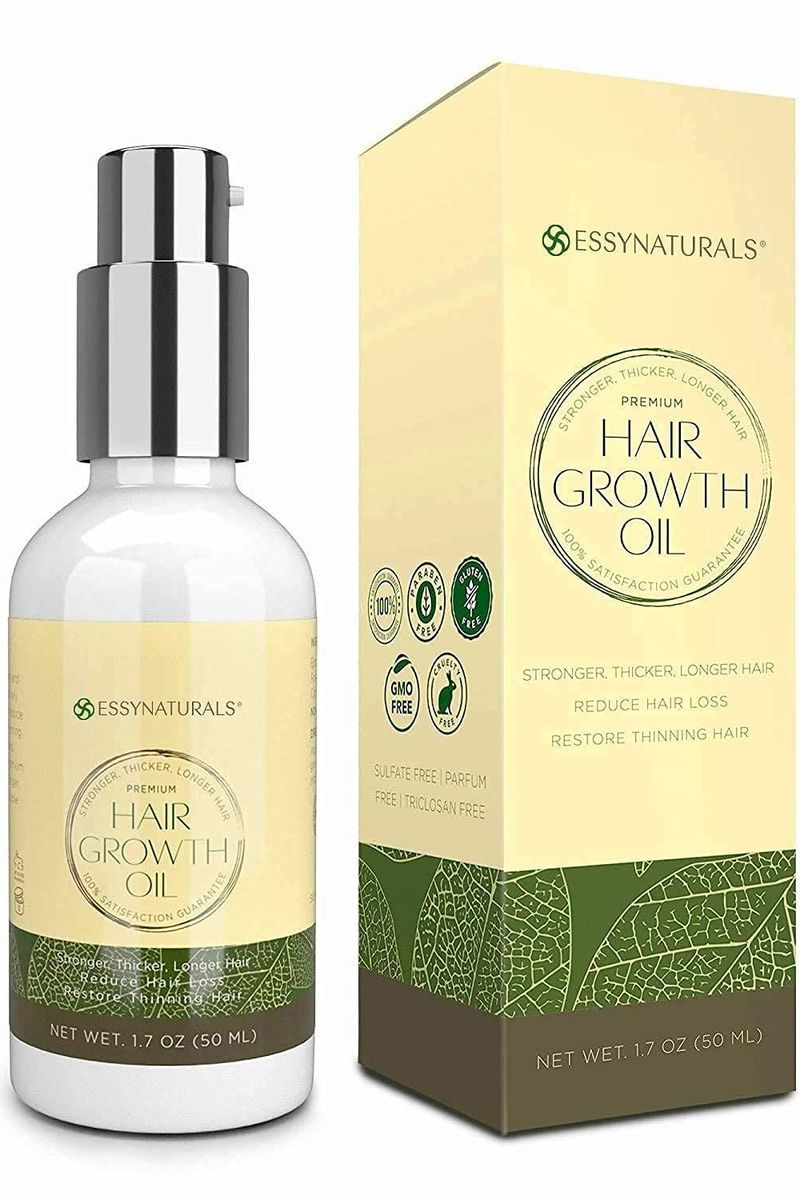
This vitamin- and antioxidant-rich oil from EssyNaturals has more than 300 five star reviews on Amazon, and is packed with castor oil and rosemary oil—both of which are ingredients that Dr. Gohara recommends for fostering healthy hair growth. The serum also incorporates caffeine, which Dr. Jerry Shapiro, a dermatologist at the New York University School of Medicine who specializes in hair loss, highly recommends. He explains, "Caffeine reverses the effects of dihydrotestosterone (DHT), the main hormone involved in hair loss."
Pros: contains natural ingredients; contains caffeine
Cons: thick, so overuse can make scalp appear greasy
Customer Review: "This stuff is amazing. Just a couple drops rubbed into my hair instantly made it look and feel thicker. It seems to be working and growing more hair after only about a week of daily use." -Walmart
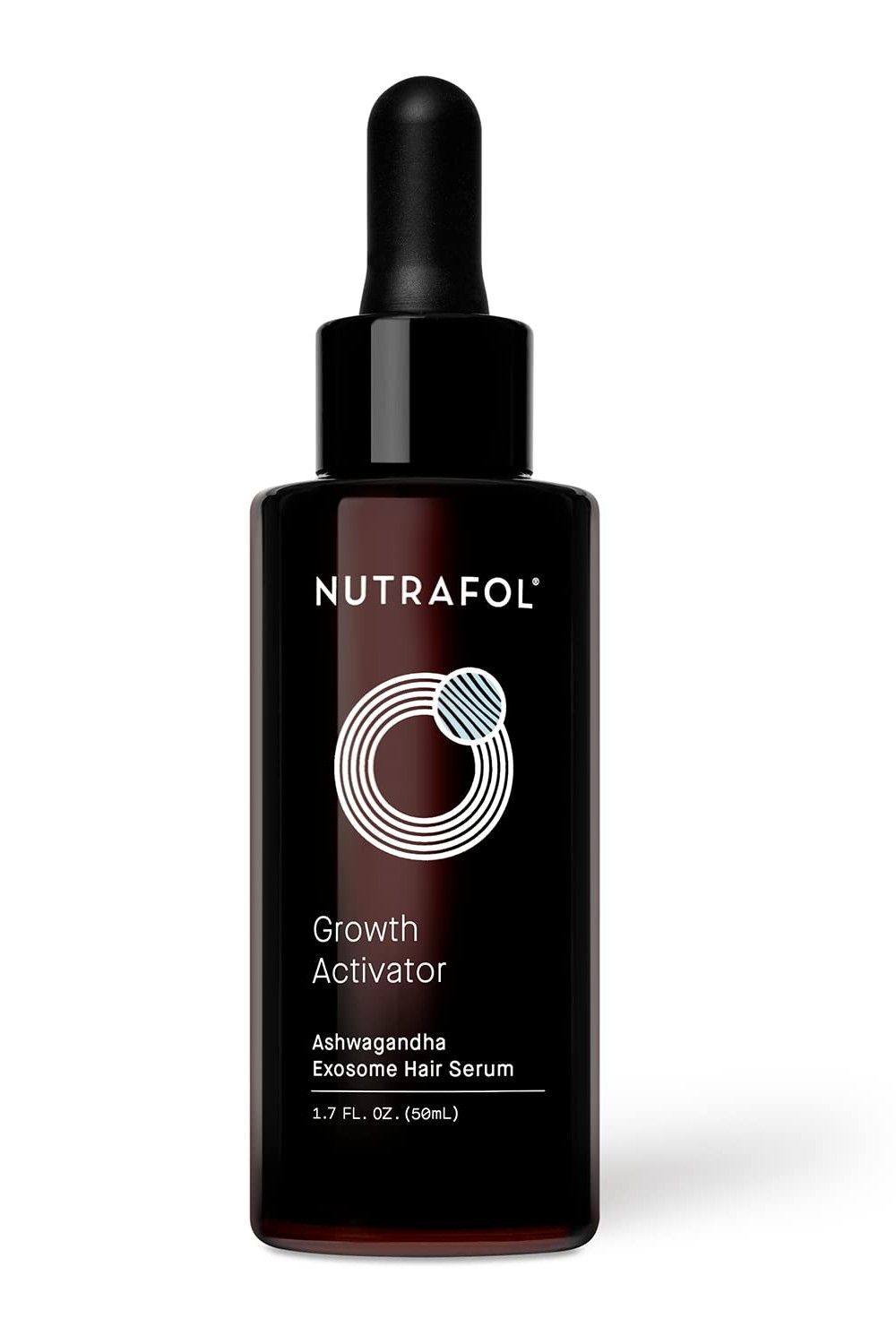
Nutrafol is beloved for its line of hair growth products, including vitamins, a powder, and topical products like shampoos, conditioners, masks, and leave-in products. This particular hair growth oil is loved by users, one of whom noted that the formula increased hair growth and, perhaps more crucially, decreased hair loss and breakage to make for a visibly thicker mane. Made with natural ingredients like pea sprout extract, ashwagandha exosomes, and Irish moss peptides, it’s packed with protein and vitamins to make for strands that are healthy from the inside out.
Pros: beloved by customers; contains natural ingredients like ginseng; decreases shedding
Cons: expensive
Customer Review: "I tried many different hair serums. I like this one the most. It does not leave my hair greasy and absorbs fast." -Rejuvent Skincare
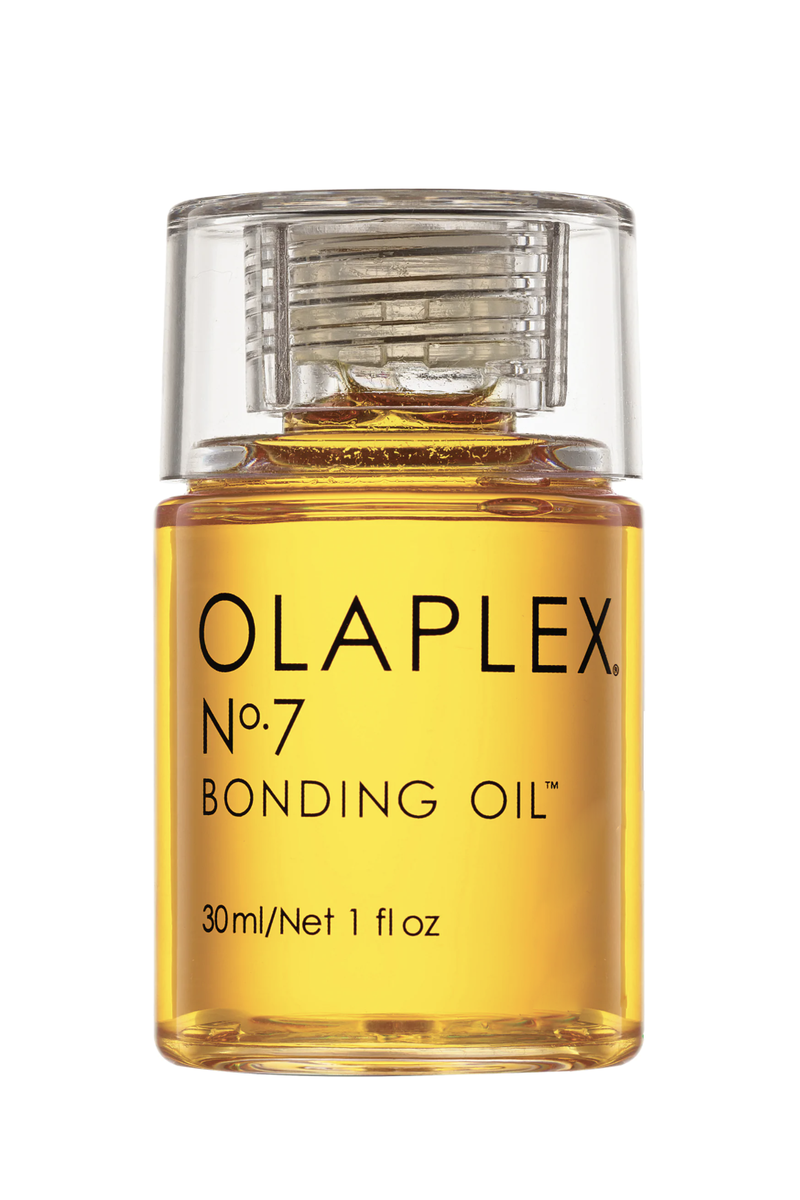
This oil uses fermentation to strengthen the impact of its key ingredient, green tea. How does fermentation help, you ask? "Fermentation breaks down natural molecules and makes them smaller, so it’s easier for them to absorb deeper into your skin’s surface," says dermatologist Dr. Lindsey Zubritsky. That means that this oil will effectively penetrate the pores of your scalp so you can easily achieve your longest, healthiest locks yet. It’s also unscented and gluten-free, so you won’t need to worry about it irritating your scalp.
Pros: contains natural ingredients like green tea; fermented skincare (strong); top-rated
Cons: high price for small bottle
Customer Review: "I LOVE this oil! It works great whether your hair is already dry or damp. Perfect for extra lightweight moisture and frizz!" -Sephora
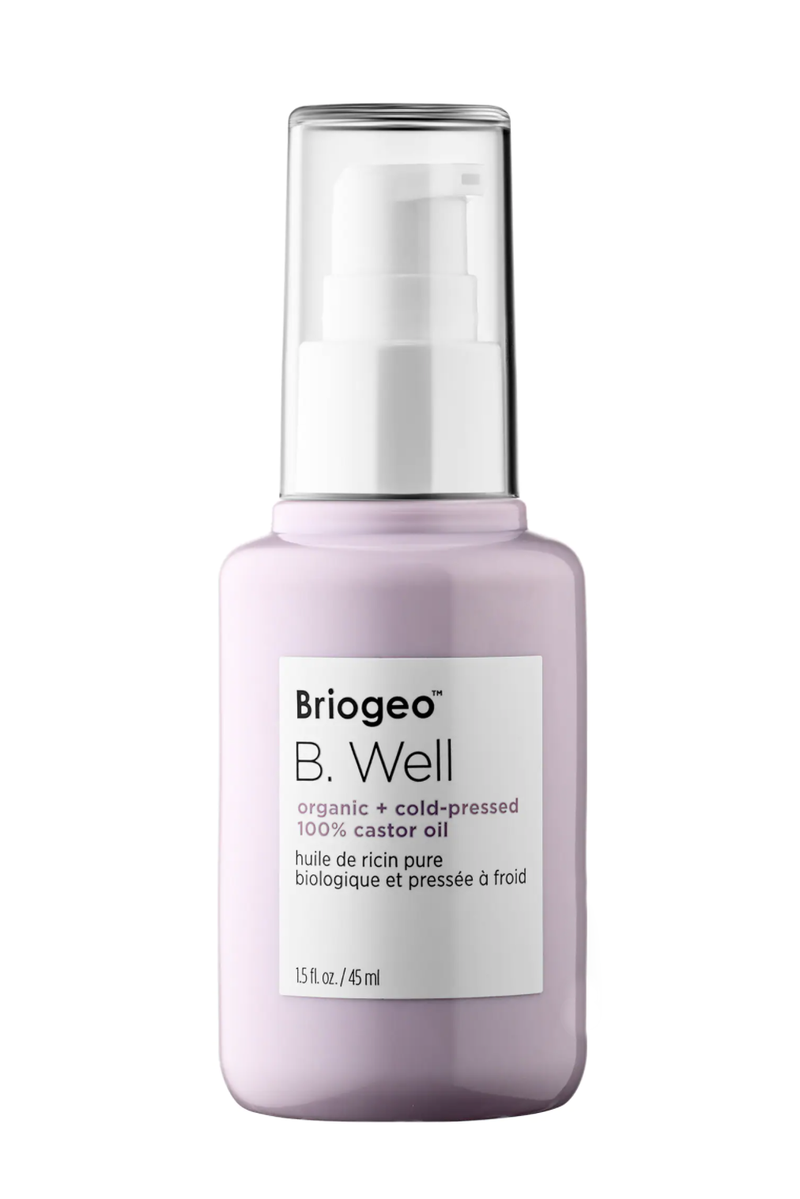
Not all castor oil is created equal or up to Briogeo's beauty standards. This castor oil is cold-pressed to preserve the harvested seeds' nutrients, and reviewers use this not only on their scalp, but on lashes, brows, and other areas where their hair follicles need a little extra love. Beauty director Deena Campbell says that she started by using this product to fill in sparse areas in her eyebrows, which had fallen victim to over-plucking. "And now," she says, "I’ve graduated to using it for my edges—which are hairs I’ll forever go to great lengths to preserve."
Pros: clean; vegan; visible results; fan-favorite; editor-approved
Cons: none found
Customer Review: "I absolutely love and recommend this product to anyone suffering from hair loss." -Sephora

This activator promises to lengthen hair by 20 percent (!!), and heavily features citrus oils, which Dr. Gohara lists among her hair growth oil essentials. While the container is small, a little goes a long way, and there is enough product inside to last users for eight weeks. Developed by hair biologists and extensively tested for efficacy, it’s made with a moisturizing blend of antioxidants and proteins, including keratin, to strengthen hair from root to tip. According to one simple yet compelling review, "This product is magic."
Pros: dermatologist-recommended; developed by hair biologists; top-rated
Cons: high price point; small bottle
Customer Review: "I just finished my first bottle of Reverse Activator. It did not discolor my hair like other products. I have less hair loss and more hair in my target area (top back part of my head). I will continue to use this product—it really works." -Dermstore
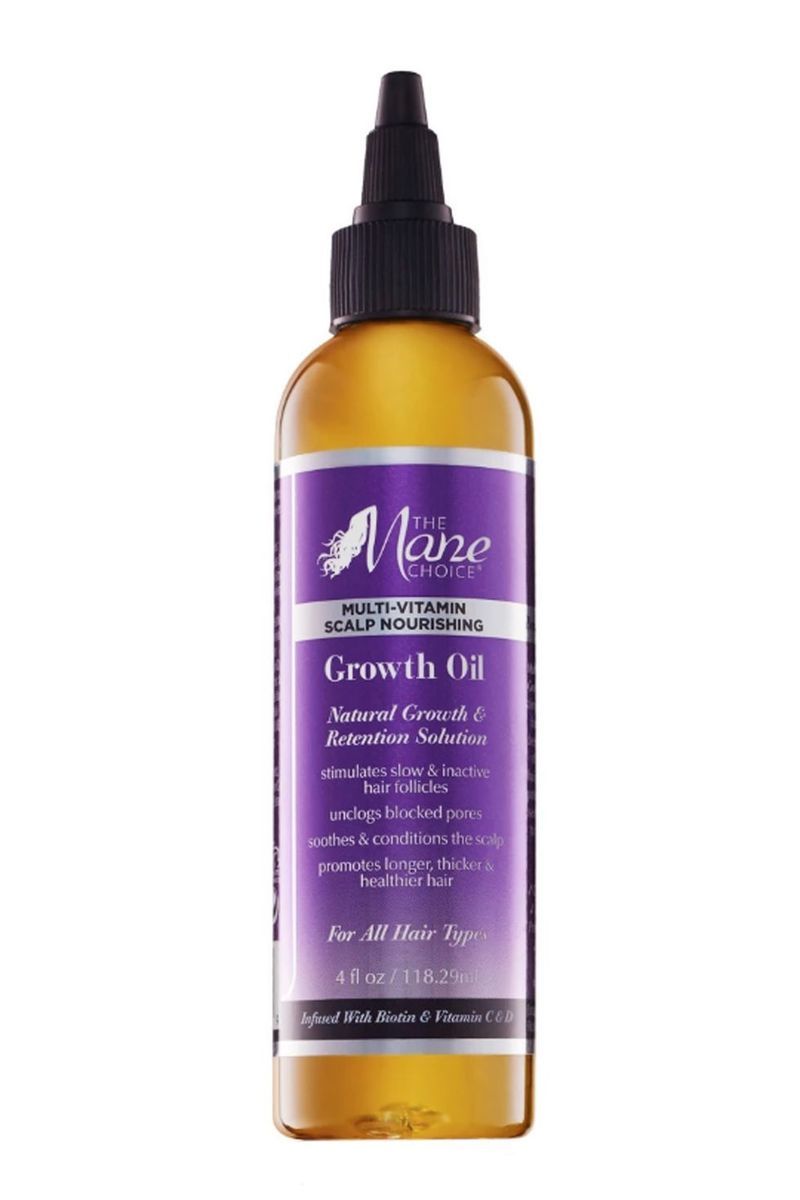
This cruelty-free product contains jojoba oil, which Dr. Gohara highly recommends looking for a hair growth oil. Cruelty-free and gentle enough for daily use, it’s also loaded with other natural ingredients like soybean oil, castor oil, sweet almond oil, rice bran extract, tea tree oil, sage leaf extract, and more—but is free of harmful parabens or sulfates. While its formula is rich, it’s made to nourish the scalp without leaving it or your roots greasy. And with a price point under $15, you truly can’t go wrong.
Pros: dermatologist recommended; paraben-free; affordable
Cons: thick, so can make thin hair look greasy
Customer Review: "I fall in love the this oil instantly, it helped my hair so much and my hair got a lot thicker." -Ulta

"The Natucain Hair Activator is my go-to hair serum because of its patented MKMS24 plant based technology that supports the appearance of stronger and fuller looking hair," says Dr. Gohara. She goes on to explain, "Ingredients are very important to me when I look at a product, which is how I initially got interested with this brand, but the results are even better!" The formula’s ingredients are of 100 percent natural origins, and are made to ameliorate breakage. One bottle of this product lasts for about three months, but according to the brand, you can expect to see results in just eight to 12 weeks.
Pros: dermatologist-recommended; plant-based
Cons: expensive
Customer Review: "After experiencing postpartum hair loss this product came in to save the day. I'm well on my way to my pre-baby hair texture and volume." -Target

I'm a huge fan of this hair growth oil, which features argan oil, chia seed oil, jojoba oil, and a myriad of other gentle, natural ingredients. While I have a lot of dense hair, my strands themselves are thin, so I'm often concerned about my scalp looking greasy. This oil, however, absorbs beautifully into my scalp without making it look or feel slick. Plus, it smells fantastic. To use, simply part towel-dried hair in one-inch increments along the scalp, from ear to ear, tracing the oil down each part line along the way. Rub in with your fingertip to ensure absorption.
Pros: natural ingredients; made with natural hair in mind; gentle; editor-approved
Cons: very small bottle
Customer Review: "The drip is everything! It makes my hair so soft, and feels great on my scalp." -Juices & Botanics

This unique formula uses organic pea sprout extract, Chinese Scullcap, soy, caffeine, and wheat sprouts to stimulate hair root for increased hair density. Plus, it features another one of Dr. Gohara's favorite ingredients: Castor oil, which has long been beloved for its restorative effect on hair health. It’s a perfect product for those experiencing thinning or a receding hairline along the top of their scalp. Plus, it works well on all hair types and curl patterns, enhancing volume and making hair look fuller in just 12 weeks.
Pros: uses natural ingredients like castor oil; contains caffeine to stimulate hair growth
Cons: strong smell
Customer Review: "I was really depressed about the hair loss but this product made me feel better about myself when I started to notice regrowth around my edges and temples." -Dermstore

This hair growth oil is formulated with CBD, which strengthens hair follicles at the root level. Furthermore, its chemical-free makeup is crucial for long-term hair growth. Several customer reviews attest to less hair loss, increased hair growth, and thicker strands after using the formula for a few weeks. Optimal results are expected to occur after four months of daily use, and the formula is made to cater to all users: It’s 100 percent vegan, color-safe, cruelty-free, and doesn’t contain silicones, phthalates, sulfates, or parabens. Even its bergamot fragrance is synthetic-free.
Pros: clinically tested; vegan; contains CBD
Cons: small bottle
Customer Review: "A serum that actually works! I started losing so much hair last year and started seeing my line receding. I immediately started looking for products that stimulated hair growth and stumbled upon Vegamour. This serum is so easy to use; it has a watery consistency, doesn’t feel sticky and doesn’t make the hair oily. I use it every other day as soon as I get out the shower. Within three months of using it, I’ve noticed a huge difference. I have a ton of baby hairs now!! Will definitely continue to use, and would recommend for anyone who is experiencing the same!" -Sephora
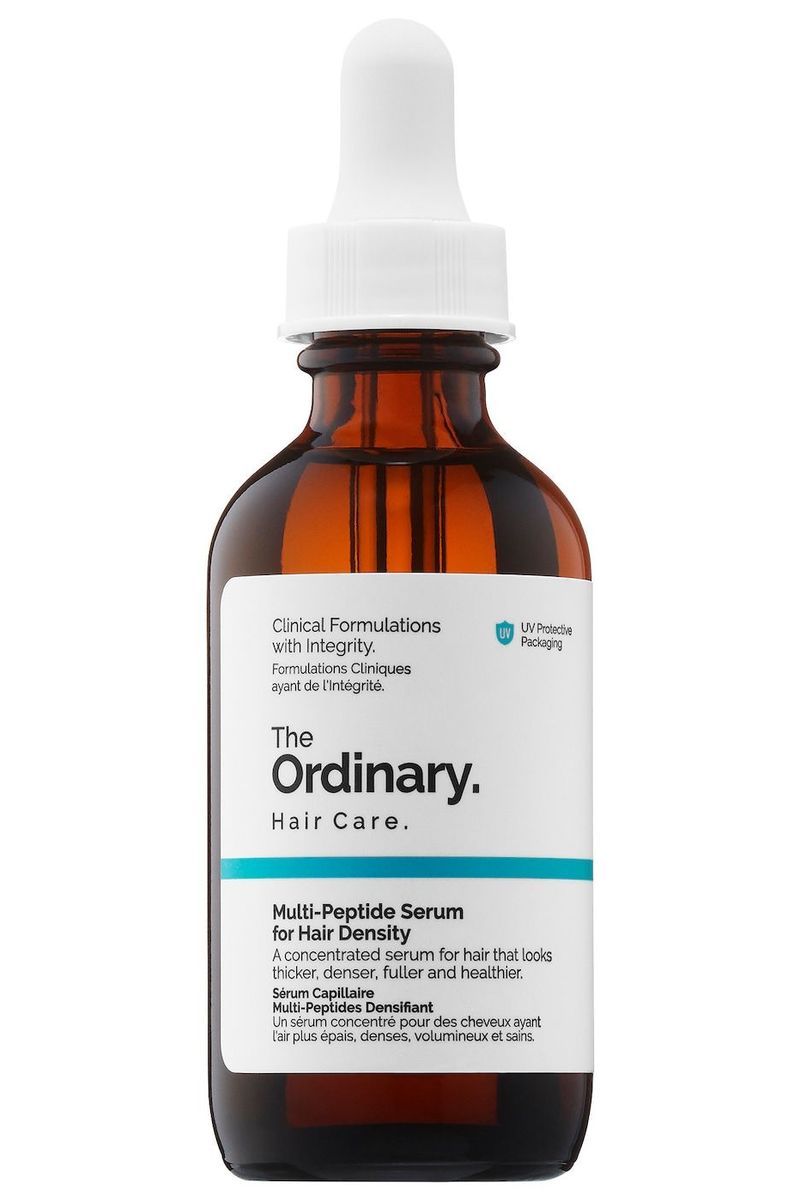
Dr. Gohara warns that consumers should "avoid hair oils that contain primarily silicones if you want more than just an instant fix." While scientific studies have not yet come to a consensus about whether silicones—which smooth hair in the short-term— are harmful or helpful to long-term hair health, avoiding synthetic materials in hair growth products is a good rule to live by. This silicone-free formula from The Ordinary checks this crucial box, opting for a vegan formula that employs ingredients like caffeine, Camellia Sinensis Leaf extract, Larix Europaea Wood extract, and more.
Pros: silicone-free; affordable; alcohol-free; works on all hair types
Cons: some users said it left buildup and residue
Customer Review: "Not only did this help my hair grow, but it made it so much thicker as well!" -Ulta
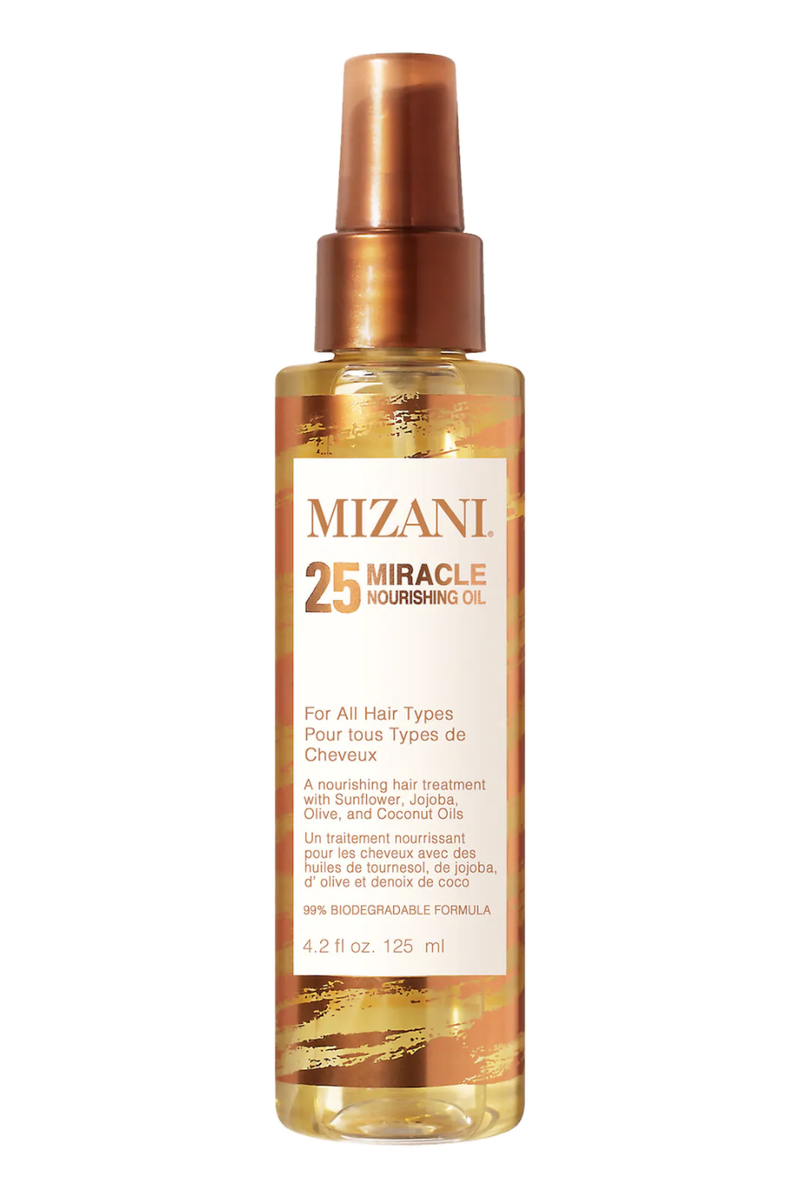
Dr. Gohara counts jojoba seed oil and coconut oil among her most desirable hair growth oil ingredients, and both are included in this formula. It's also silicone-free and combats hair and scalp dryness. To avoid greasiness, though, one reviewer helpfully instructs, "The best way that I have found that this works is by slightly dampening my hair first, then adding a few drops of this oil into my palm, rubbing my hands together, then running through my hair, especially the parts that seem more damaged."
Pros: decreases frizz; contains natural ingredients like coconut oil; silicone- and sulfate-free
Cons: thick, so may make thin hair look greasy at the roots
Customer Review: "I love this oil! It smells amazing, it’s light and it doesn’t leave my hair feeling greasy. I only apply it to my scalp and I know longer have issues with my scalp feeling itchy and dry." -Sephora

Beauty editor Samantha Holender swears by this oil. "I have ridiculously thin hair, so applying hair oil is a risky business. I typically end up looking like a greasy mess," she says. "But this sulfate-free, paraben-free, lightweight one is the exception to the rule. It gives my hair shine (not oil), seals my split ends (there are many), and smells delicious (think: fresh meets citrus). Over the course of a few weeks, I noticed that my hair felt stronger overall—my stands looked less fried and felt stronger."
Pros: sulfate- and paraben-free; reduces frizz; enhances shine; editor-approved
Cons: high price point for small bottle; more suited for straight than curly hair
Customer Review: "This is the best oil I have ever used in my life. It’s honestly worth every penny. It’s literally magic in a bottle. It’s fixed my frizzy hair and just made my hair healthier. If you’re thinking about buying it, do it." -Sephora

This clean product works well for all hair types, but was formulated with curly and natural hair in mind. It’s made to enhance shine and protect the scalp and hair from UV damage—something that’s particularly helpful for skin on the part line(s). For those suffering from dandruff or dry, flaky scalps, it’s also great at balancing the skin and eradicating buildup and flakes. Customers are particularly pleased with how effective it is for taming frizz, and users with natural hair say it’s perfect for using before donning protective hairstyles like braids.
Pros: good for curls; good for natural hair; provides scalp with UV protection
Cons: strong smell; thick, so may make thin hair look greasy
Customer Review: "This oil is nourishing yet so lightweight. I’ve been using it on silk pressed hair and my hair looks so shiny and healthy. I also use it after a flat iron and my hair comes out way more flowy as the oil doesn’t weight the hair down. A bonus is that it smells amazing!" -Sephora

This paraben-free, sulfate-free formula's organic origins make it safe for long-term use on natural hair, and customers rave about its results. Top reviews say that results manifest themselves within a month, that the formula smells divine, and that it even helps with styling. You can apply it straight to your scalp by either using a scalp massager or applying along your part line(s), or you can apply it to the hair shaft to add shine. One reviewer writes, "My hair has never been so soft and my curls are so much more defined than ever before."
Pros: made with natural hair in mind; moisturizing; good for curls
Cons: contains sulfates; contains alcohol; has a sweet smell that may be polarizing
Customer Review: "If you want to enhance your curly or wavy hair then this hair oil will bring out the best of your hair. This product is also effective for moisturizing your scalp to prevent and eliminate any dryness and accompanying itch." -iHerb
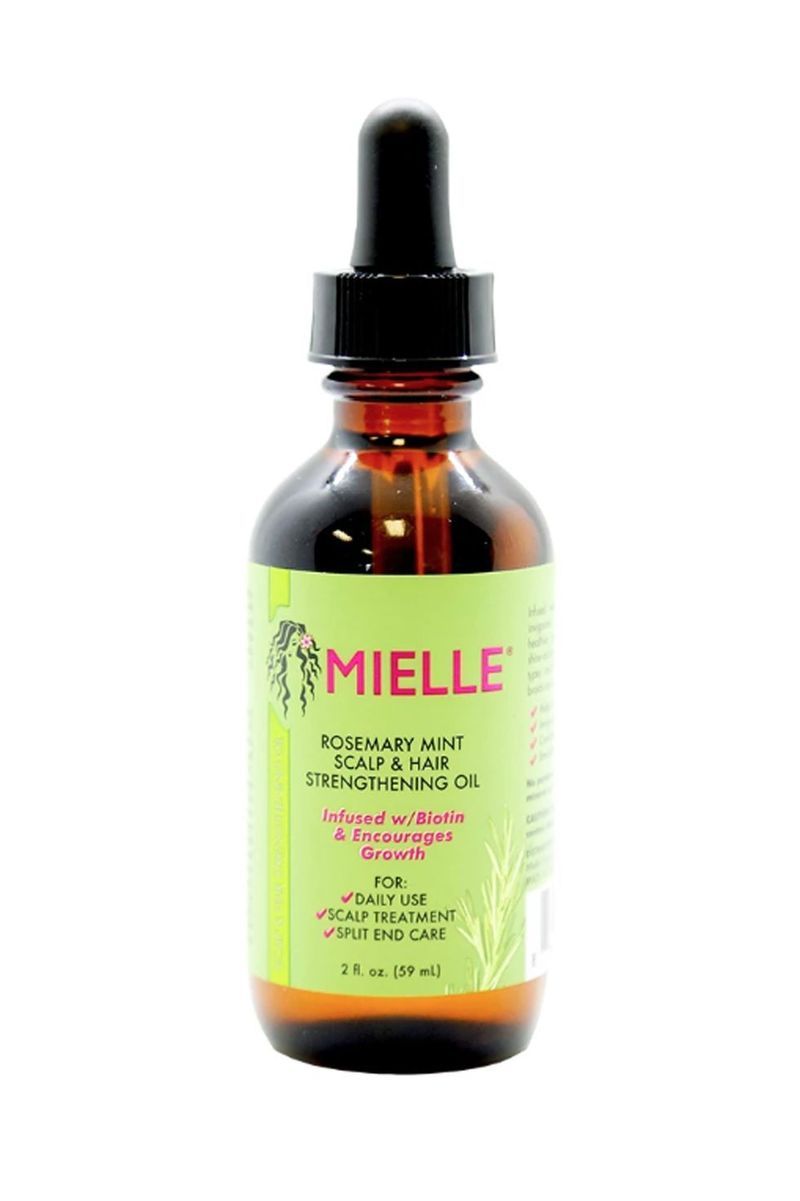
This hair growth oil has gone viral several times over the course of the last year, and with good reason. It improves hair growth and retention by strengthening the hair and stimulating the scalp, resulting in a tingling feeling that’s cooling and pleasant rather than overwhelming. It’s particularly well-suited for those with thick, curly, and/or natural hair, and several reviewers say that it's a great alternative to castor oil if you find the latter to be too thick or sticky.
Pros: lightweight; cruelty-free; sulfate-free; Black owned business
Cons: strong smell
Customer Review: "Amazing! Helped with hair growth on bald spots and length! You just have to be consistent with it for results (one to three times a week)" -Target
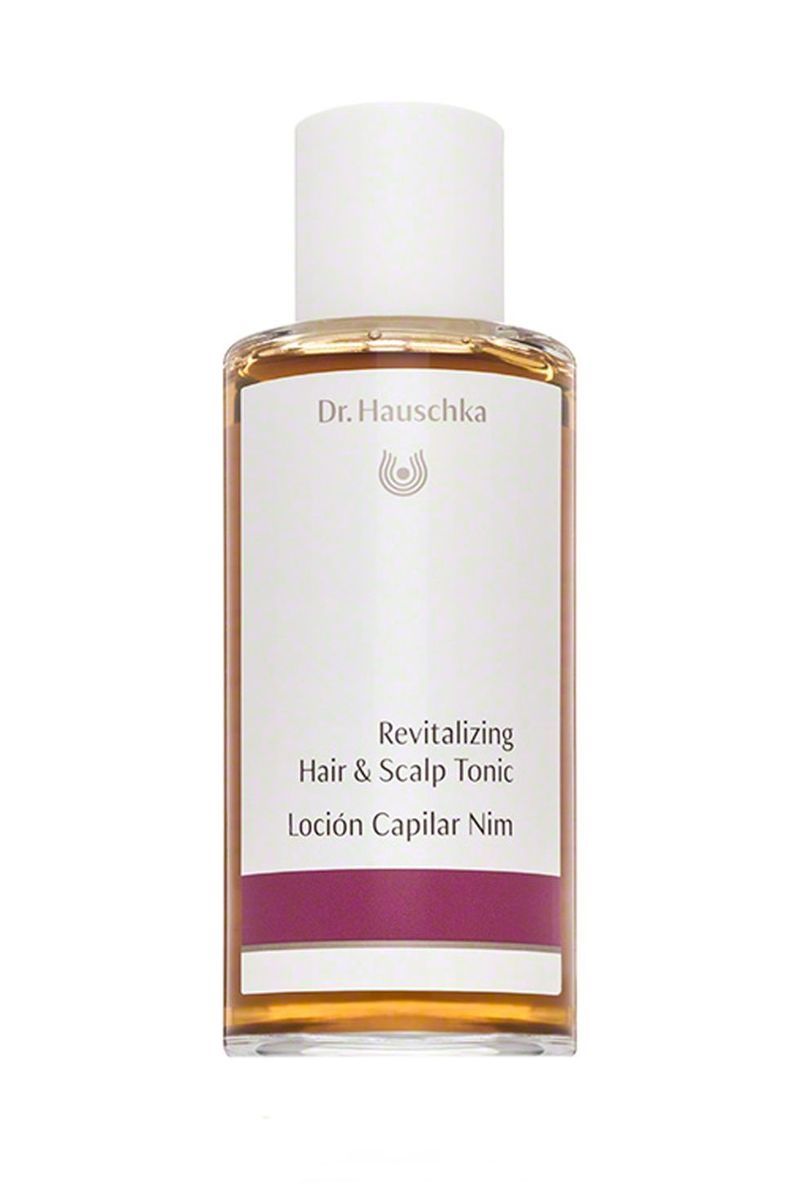
Hair growth begins with a healthy scalp, and this formula from Dr. Hauschka is designed for just that. Its main ingredients include natural oils like citronellol, geraniol, limonene, and linalool, all of which stimulate the scalp. The product is an ideal solution for those with sensitive scalps, because multiple users report decreased dandruff, oiliness, itching, and overall scalp irritation after consistent use. It’s also cruelty-free, incorporates organic, fair trade ingredients, and doesn’t contain and synthetic fragrances, preservatives, or artificial colors.
Pros: moisturizing; easy application (sprays on); good for sensitive scalps
Cons: strong smell; small bottle
Customer Review: "I’ve been using this hair tonic consistently every night for about two weeks. I’ve already noticed that my hair is stronger and shinier." -LovelySkin
Getting Healthy Hair
Hair growth oils can go a long way in supporting your overall hair health, but there are a number of other crucial steps one should take to grow (and sustain) thick, healthy hair. Trichologist and president of the Philip Kingsley clinic and haircare brand, Anabel Kingsley, reminds us that hair health starts from the inside. Thus, if you want gorgeous, flowing locks, you need to minimize stress (which she says "can exacerbate hair thinning"), drink plenty of water, and follow a healthy diet rich in nutrients such as protein and iron.
Kingsley also says that hair thinning should first and foremost be addressed "by optimizing the scalp environment and providing internal nutritional support." For that reason, many hair growth oils focus on supporting a well-moisturized, healthy scalp so that hair follicles can thrive.
Finally, if you want longer, healthier hair, be sure to keep up with your trims and to style carefully. Hairstylist and founder of HERcurls Haiya Eliza recommends getting a haircut at least once every three to four months, and to always get it cut in its natural state. "If you're straightening your hair to cut it, then you're damaging your hair in the process of cutting it," she warns, "and if you go to wear it curly, you're not going to have the same shape as you did when you cut it, because you cut it when it was styled a different way. And you've also applied heat to it, so you've damaged and weakened any curls you have."
Too attached to your length to get a hair cut? Haiya says that eschewing haircuts can actually cause more damage—and hinder your length—because the longer you wait between haircuts, the more likely you are to get split ends. "Naturally, we all get split ends," she says. "A strand will split into two, and that split will keep running up the strand until you stop it. So what happens is you have one strand that's become half a strand, and those two strands just keep breaking off as you brush it, detangle it, and so on. So while it's continually growing, it's also continually breaking, and when that happens, you end up losing rather than retaining length."
Meet the Experts
Dr. Mona Gohara is a board-certified dermatologist who graduate medical school with AOA Honors before training as a dermatologist at Yale. Currently, she is the vice president of the Women’s Dermatologic Society as well as a member of The American Academy of Dermatology and The American Society For Dermatologic Surgery.
Dr. Shapiro is a dermatologist at the New York University School of Medicine who specializes in hair loss and combatting both and female- and male-pattern hair loss. He is particularly committed to finding healthy, nonsurgical methods of fighting hair loss and thinning.
Dr. Lindsey Zubritsky is a board-certified dermatologist who specializes in general medical dermatology, surgical dermatology, cosmetics, and pediatric dermatology. She is active on social media and passionate about demystifying skincare and debunking dermatological misconceptions. She is also a social media ambassador for and Fellow of the American Academy of Dermatology, an editor for the Journal of the American Academy of Dermatology (JAAD), and has contributed to a number of magazines.
Haiya Eliza is a Cuban-Bolivian hairstylist and founder of HERcurls, a brand focused on educating curl-owners about how to best care for and style their hair. Originally from Miami, she is currently based in Dallas, Texas.
Peter C. Young, MD is the Keeps Medical Director and a board-certified dermatologist. Dr. Young had a distinguished career serving as a physician in the U.S. Army for nine years before going on to practice dermatology in Massachusetts for 22 years. In addition to his published medical articles, Dr. Young has also been a speaker at national medical meetings on teledermatology and is a fellow of the American Academy of Dermatology. Dr. Young is currently located in Estero, FL.
Gabrielle Ulubay is an E-Commerce Writer at Marie Claire and writes about all things beauty, sexual wellness, and fashion. She's also written about sex, gender, and politics for publications like The New York Times, Bustle, and HuffPost Personal since 2018. She has worked extensively in the e-commerce and sales spaces since 2020, including two years at Drizly, where she developed an expertise in finding the best, highest quality goods and experiences money can buy. As a film school graduate, she loves all things media and can be found making art when she's not busy writing.
-
 Hollywood's Next A-List
Hollywood's Next A-ListYou may not recognize all of them...yet. But these 22 individuals have delivered some of the most triumphant on-screen performances in recent memory.
By Neha Prakash
-
 The Ambition Issue
The Ambition IssueA celebration of striving for success in whatever's most important to you.
By Marie Claire Editors
-
 I Quit My Job as a CEO to Become an Intern
I Quit My Job as a CEO to Become an InternIn an excerpt from her memoir, Alisha Fernandez Miranda takes a one-year break from her role as CEO at a consulting firm to try out the jobs she's always dreamed of doing.
By Alisha Fernandez Miranda
-
 The 20 Best Hair Masks for Damaged Hair, According to Experts and Editors
The 20 Best Hair Masks for Damaged Hair, According to Experts and EditorsHealthy strands, here we come!
By Gabrielle Ulubay
-
 How Often You Should Wash Your Hair, According To Experts
How Often You Should Wash Your Hair, According To ExpertsKeep it fresh, my friends.
By Gabrielle Ulubay
-
 The 11 Best Magnetic Lashes of 2023
The 11 Best Magnetic Lashes of 2023Go ahead and kiss your messy lash glue goodbye.
By Hana Hong
-
 The 30 Best Hair Growth Shampoos of 2023, According to Experts
The 30 Best Hair Growth Shampoos of 2023, According to ExpertsRapunzel hair, coming right up.
By Gabrielle Ulubay
-
 The 23 Best Beauty Advent Calendars of 2023
The 23 Best Beauty Advent Calendars of 2023The gift that keeps on giving—literally.
By Julia Marzovilla
-
 The 18 Best Natural Hair Products in 2023
The 18 Best Natural Hair Products in 2023Remember: Your curls are your crown.
By Gabrielle Ulubay
-
 The 9 Best Hot Rollers for the Curls of Your Dreams
The 9 Best Hot Rollers for the Curls of Your DreamsThis is how we roll.
By Samantha Holender
-
 The 12 Best Cream Eyeshadows, According to Makeup Artists
The 12 Best Cream Eyeshadows, According to Makeup ArtistsThe best part? They’re so easy to apply.
By Samantha Holender

